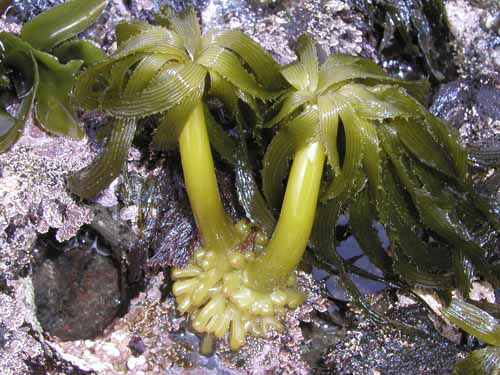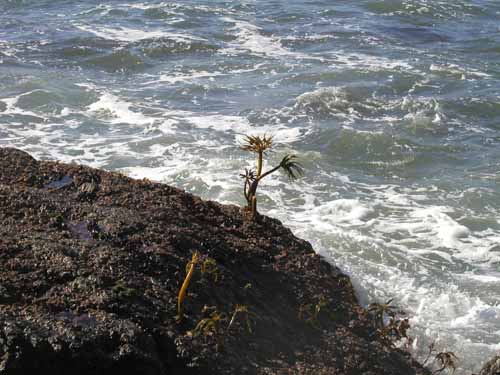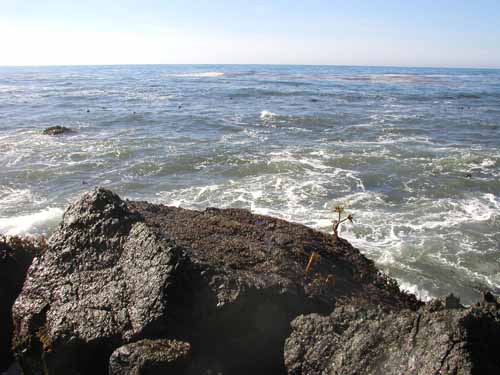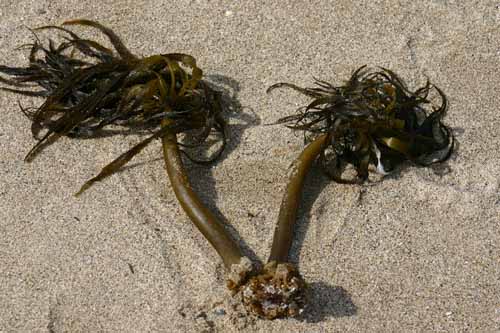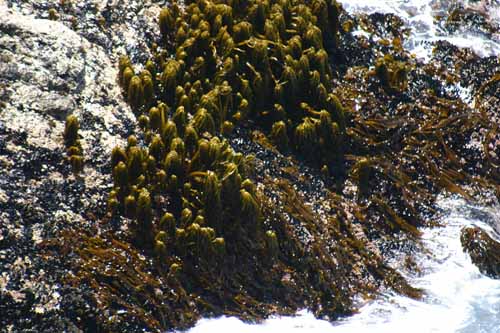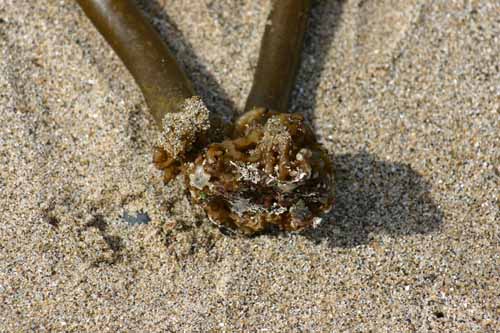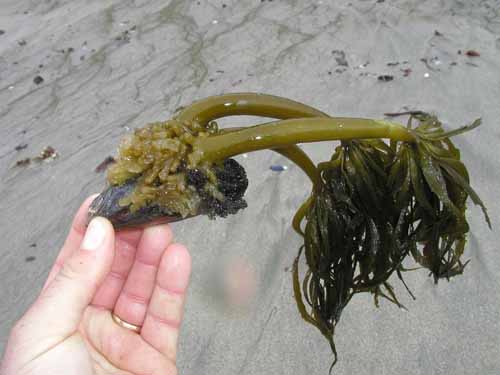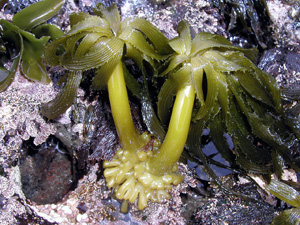
Sea palm
Postelsia palmaeformis
Overview
Key Features:
Brown, short, thick and round stipe (often to 30 cm tall) topped with dozens of blades that hang downwards, often to the rocky reef itself.Primary Common Name:
Sea palmGeneral Grouping:
Brown seaweed/algaeGeographic Range:
Hope Island, British Columbia to San Luis Obispo County, California
Postelsia palmaeformis is found from Hope Island, British Columbia to San Luis Obispo County, California.Intertidal Height:
-2 to -1 feet (-0.6096 to -0.3048 meters)Notes:
Postelsia palmaeformis is usually found in the low intertidal, but in some areas can exist into the mid intertidal.Subtidal Depth Range:
Minimum Depth: 0 meters or 0 feetMaximum Depth: 0 meters or 0 feet
Notes:
Not found subtidally.Habitats:
exposed rocky shoreNotes:
Postelsia palmaeformis is abundant in exposed rocky habitats from the mid to low intertidal. This kelp forms dense stands during the summer in areas that are pounded by surf. Postelsia palmaeformis can also grow in clumps in beds of the California mussel Mytilus californianus.Abundance:
Relative Abundance:
It can be locally abundant, but is relatively rare in central California.Species Description:
General:
Postelsia palmaeformis is an annual kelp that resembles miniature palm trees. Palmaeformis literally means: having the shape of a palm tree. This brown algae will form dense stands during the summer in rocky habitats pounded by surf.Distinctive Features:
Postelsia palmaeformis has a small, stout, and densely branched holdfast that supports a hollow cylindrical stipe. The top of the stipe has numerous branches, each of which carries a single, narrow, dropping blade. A single individual can have up to one hundred blades or more, each up to 25 cm long. Additional blades can be produced through the splitting of pre-existing blades. These blades are covered with longitudinal grooves that contain sporangia.Size:
Postelsia palmaeformis grows up to 60 cm tall.Natural History:
General:
The tough and flexible stipe of Postelsia palmaeformis is extremely resistant to wave shock. Postelsia palmaeformis provides protection for other species enabling them to survive in an environment otherwise too rigorous on account of surf. Postelsia palmaeformis will often settle onto other algal and animals species, it is particularly abundant in patches within beds of Mytilus californianus. By settling onto and among other species, Postelsia palmaeformis increases the probability of both being ripped from the substratum and overgrowing and smothering other species. The end result is a clear substratum for the use of sporophytes of their own species.Predator(s):
Postelsia palmaeformis is considered a delicacy. The stipe and the blades can be pickled, steamed or eaten fresh. In California Postelsia palmaeformis is protected and unlicensed harvesting is prohibited due to its popularity as an edible.Feeding Behavior:
PhotosyntheticSeasonal Behavior
April - May
Reproduction:
Spores of Postelsia palmaeformis develop in grooves on both sides of the blades in late spring. They are released during low tide, dripping down onto nearby rocks and adhering quickly. Therefore, most dispersal is limited to distances of 1 to 5 meters. Long-distance probably only occurs as a result of floating individuals that have been ripped off the substratum. Within a clump of Postelsia palmaeformis, the individuals are siblings.References
O'Clair, R.M. 2000. North Pacific Seaweeds. Plant Press, Auke Bay, Alaska. 162 p.
- Dayton, P. 1973. Dispersion, dispersal, and persistence of the annual intertidal alga, Postelsia palmaeformis Ruprecht. Ecology 54: 433-438.
- Mondragon, J. 2003. Seaweeds of the Pacific Coast: common marine algae from Alaska to Baja California. Sea Challengers, Monterey, CA. 97 p.
- Ricketts, E. F., J. Calvin, and J.W. Hedgpeth. 1985. Between Pacific tides. Stanford University Press, Stanford, CA. 652 p.
Related Information
Photo Library
Click on an image below to view a larger version in the SIMoN Photo Library. You will also be able to view important information on each photo such as photographer, date, caption and more
